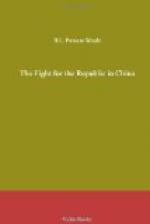The question is something more than one of academic or even merely judicial importance. As has been stated, the Koreans in Yenchi outnumber the Chinese and the only thing that has kept the region Chinese territory in fact as well as in name is the possession by the Chinese of jurisdiction over every inhabitant, whether Chinese or Korean. Were China to surrender that jurisdiction over a majority of those inhabitants, it would be tantamount to a cession of territory.
2nd MACAO
The dispute between China and Portugal over the Macao question has been one of long standing. The first treaty of commerce signed between them on August 13, 1862, at Tientsin, was not ratified in consequence of a dispute respecting the Sovereignty of Macao. By a Protocol signed at Lisbon on March 26, 1887, China formally recognized the perpetual occupation and government of Macao and its dependencies by Portugal, as any other Portuguese possession; and in December of the same year, when the formal treaty was signed, provision was made for the appointment of a Commission to delimit the boundaries of Macao; “but as long as the delimitation of the boundaries is not concluded, everything in respect to them shall continue as at present without addition, diminution or alteration by either of the Parties.”
In the beginning of 1908, a Japanese steamer, the Tatsu Maru, engaged in gun-running was captured by a Chinese customs cruiser near the Kauchau archipelago (Nove Ilhas). The Portuguese authorities demanded her release on the ground that she was seized in Portuguese territorial waters thus raising the question of the status of the waters surrounding Macao.
In the same year the Portuguese authorities of Macao attempted the imposition of land tax in Maliaoho, and proposed to dredge the waterways in the vicinity of Macao. The Chinese Government thereupon instructed its Minister in France, who was also accredited to Portugal, to make personal representations to the Portuguese Foreign Office in regard to the unwarrantable action of the local Portuguese authorities. The Portuguese Government requested the withdrawal of Chinese troops on the Island of Lappa as a quid pro quo for the appointment of a new Demarcation Commissioner, reserving to itself the right to refer to The Hague Tribunal any dispute that may arise between the Commissioners appointed by the respective Governments.
After protracted negotiations it was agreed between the Chinese Minister and the Portuguese Government by an exchange of notes that the respective Governments should each appoint a Demarcation Commissioner to delimit the boundaries of Macao and its dependencies in pursuance of the Lisbon Protocol and Article 2 of the Sino-Portuguese Treaty of 1887, subject to the decision of their respective Governments.
THE PORTUGUESE CLAIM
In February, 1909, Portugal appointed General Joaquim Machado and China Mr. Kao Erh-chien as their respective Commissioners and they met at Hongkong in June of the same year.




